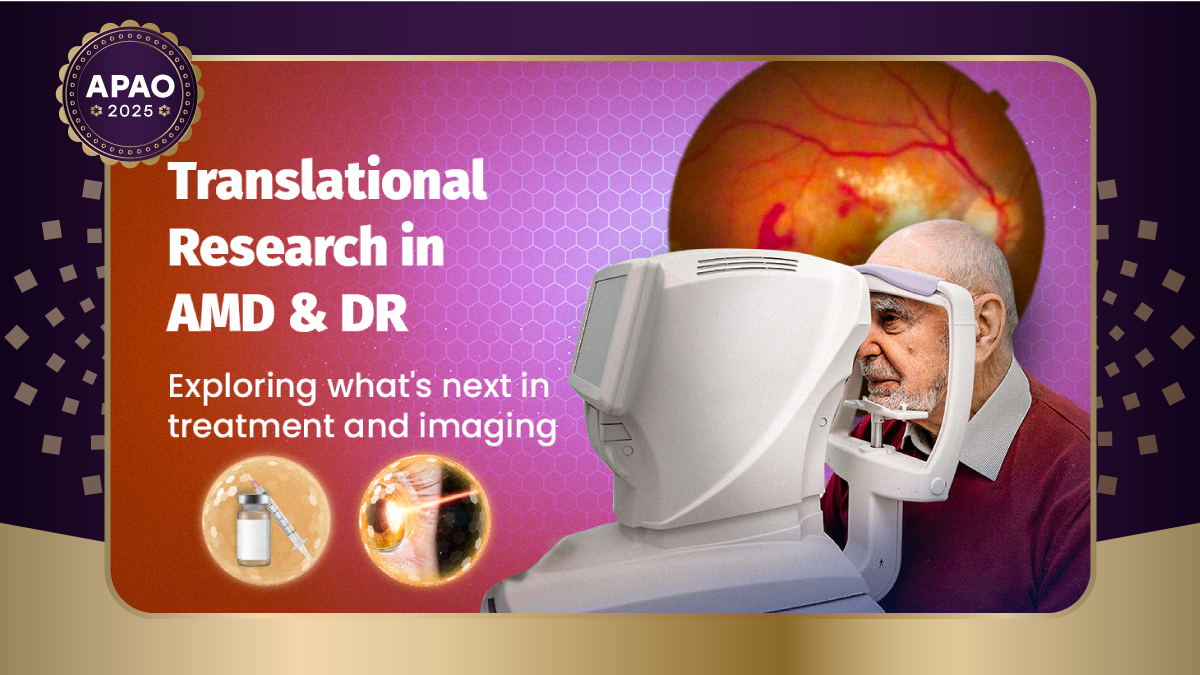From imaging biomarkers to next-gen therapeutics, experts explored translational tools shaping the future of AMD and diabetic eye disease.
At the Translational Research in Age-Related Macular Degeneration (AMD) and Diabetic Retinopathy symposium on Day 2 of APAO-AIOC 2025, three leading retina specialists explored how the latest science is changing the landscape of posterior segment care.
Chaired by Dr. Cyrus Shroff (India) and Asst. Prof. Dr. Sruthi Arepalli (United States), the session covered breakthrough findings in cytokine profiling, fundus autofluorescence imaging and gene therapy pathways—with each talk connecting the bench to bedside in novel ways.
Unpacking inflammation: The IMAGINE DME study
Asst. Prof. Dr. Sruthi Arepalli kicked off the session by challenging the conventional wisdom of a solely VEGF-driven pathology in diabetic macular edema (DME). Presenting findings from the IMAGINE DME Study,1 she revealed a more complex interplay of inflammatory mediators.
By analyzing aqueous humor samples from DME patients, she classified responders into four categories—from super responders (≥80% central subfield thickness reduction after one injection), early responders (≥50% reduction by 3 months), slow responders (<50% reduction by 3 months but achieving it later), to minimal responders (<50% reduction throughout) who stubbornly resist treatment.
Unsurprisingly, her team found super responders had significantly higher baseline VEGF levels but lower monocyte chemoattractant protein-1 (MCP-1) levels. Meanwhile, slow responders showed elevated angiopoietin-like protein 4 (ANGPTL4) levels.
Prof. Arepalli noted specific molecules that repeatedly surfaced as significant: “The things that we found that stood out to us is that IL-6 came up quite a bit in diabetic macular edema and leakage throughout the fundus… And ANGPTL4 also was prevalent in OCT macular edema and leakage, so also points to another area that we could experiment with later in the future.”
This suggests that while anti-VEGF treatments remain crucial, targeting pathways involving interleukin-6 (IL-6) and ANGPTL4 could offer therapeutic benefits, particularly for patients demonstrating suboptimal responses to current standards.
This multi-target perspective aligns with emerging treatments and makes a strong case for tailoring treatment to cytokine profiles, especially as newer therapies like faricimab come online. As Prof. Arepalli mentioned during the session’s Q&A, “we are seeing that in some patients, it has a better response than traditional anti-VEGF therapy.”
READ MORE: Beyond Anti-VEGF: Novel Therapies Show Promise in DME
The secret life of photocoagulation lesions
Moving from molecular pathways to tissue effects, Dr. Kentaro Nishida (Taiwan) provided a fascinating analysis of what happens to photocoagulation lesions over time. By classifying lesions into five groups based on fundus autofluorescence (FAF) patterns, he revealed that not all laser spots are created equal.
Most importantly, lesions exhibiting diffuse FAF patterns (Groups B and C) were associated with better retinal sensitivity compared to those lacking FAF or showing sharply demarcated hypo-autofluorescence (Groups A and D). Optical coherence tomography (OCT) analysis confirmed the structural basis for this difference, revealing better preservation of the ellipsoid zone (EZ) – indicating viable photoreceptors – in areas corresponding to diffuse FAF.
As Dr. Nishida explained, “remaining diffuse fundus autofluorescence implies existence of photoreceptors,” linking their morphology and function directly to the FAF signal observed. Dr. Nishida proposed a photocoagulation index—a metric derived from the laser-treated area ratio—as a potential guide for optimizing PRP intensity, especially in neovascular glaucoma.
Applying this clinically, his research showed that patients with severe ischemic conditions like neovascular glaucoma (NVG) required significantly higher laser density for effective treatment compared to typical PDR cases (index of 40.7% vs. 20.2%).
“The purpose of retinal photocoagulation is to destroy photoreceptors. And remaining diffuse fundus autofluorescence of autofluorescence implies existence of photoreceptors. Some autocoagulation is needed to achieve autocoagulated lesions without underscored fluorescence for severe ischemic disease like neurovascular glaucoma,”noted Dr. Nishida, explaining the therapeutic goal.
The implication here is that FAF imaging shouldn’t be considered an afterthought, but actually as a potential roadmap. It could guide not only evaluation but real-time PRP planning—supporting a more refined and retina-preserving laser approach.
READ MORE: Enhancing Low-quality Retinal Fundus Images for a More Accurate Diagnosis
A three-front war: Gene, stem cell and pharmacologic therapies in AMD
Dr. Alay Banker (India) closed the session with a tour de force of emerging AMD therapies and the future landscape of intervention. With over 100 molecules in development, Dr. Banker focused on the most promising approaches.
“Exploring the future therapies for AMD, I think basically there are three main therapies which have been researched. That is gene therapy, stem cell therapy and we also have novel pharmacological approaches,” he explained.
His talk reviewed gene therapies such as RGX-314 (REGENXBIO), ADVM-022 (Adverum) and 4D-150 (4D Molecular Therapeutics)—each targeting different VEGF pathways for longer-lasting wet AMD control. In dry AMD, options ranged from complement inhibitors like JNJ-1887 to photobiomodulation and omega fatty acids engineered for retinal neuroprotection.
He also introduced pharmacologic options like DURAVYU™ (EyePoint Pharmaceuticals, USA), a biodegradable tyrosine kinase inhibitor implant, which delivered VEGF suppression for up to six months—a potential game-changer in reducing treatment burden, saying, “I feel that ultimately it is going to be combination therapy. We have to integrate gene therapy, apply stem cells and also administer pharmacological agents to improve outcomes.”
Dr. Banker didn’t stop at the science. He closed with a playful nod to science fiction—imagining “retinal banks” where patients could receive custom implants, and even teleportation to specialized treatment centers. The audience chuckled, but the underlying point was clear: access and infrastructure remain critical hurdles in delivering advanced care globally.
The Q&A dove into real-world limitations, with panelists reflecting on the lack of access to dry AMD treatments in some regions, and the need for better metrics like contrast sensitivity and reading speed to capture patient-relevant outcomes.
READ MORE: Keeping a Lookout for New and Emerging Therapies for AMD and DME
Bridging bench to bedside in retinal disease
From deep molecular profiling to refined laser metrics and cutting-edge gene therapy, this symposium highlighted a clear shift in retinal research: from single-target approaches to multi-modal treatments addressing the complex pathophysiology of retinal diseases. Each presentation tackled different corners of AMD and DME, but together they painted a picture of multifaceted management, increasingly defined by individual response profiles, imaging analytics and multi-modal therapeutics. Clearly, the future of retinal care is extremely bright and delightfully complex.
As speakers emphasized, innovation must go hand in hand with functional outcomes, accessibility and clinical common sense. In the coming years, integrating these diverse approaches may be less about finding a silver bullet—and more about crafting the right cocktail for each patient.
Editor’s Note: Reporting for this story took place during the 40th Congress of the Asia-Pacific Academy of Ophthalmology (APAO 2025), being held in conjunction with the 83rd Annual Conference of the All India Ophthalmological Society (AIOC 2025) from 3-6 April in New Delhi, India.
Reference
- Kar SS, Abraham J, Wykoff CC, et al. Computational Imaging Biomarker Correlation with Intraocular Cytokine Expression in Diabetic Macular Edema: Radiomics Insights from the IMAGINE Study. Ophthalmol Sci. 2022;2(2):100123.



